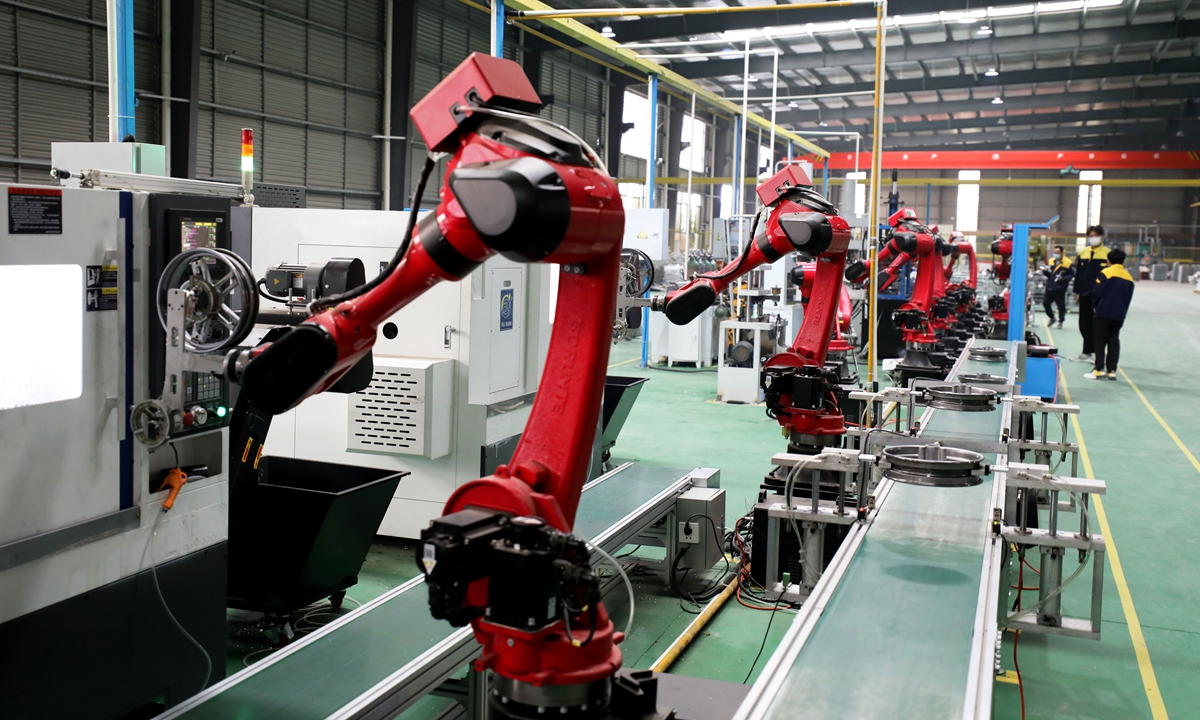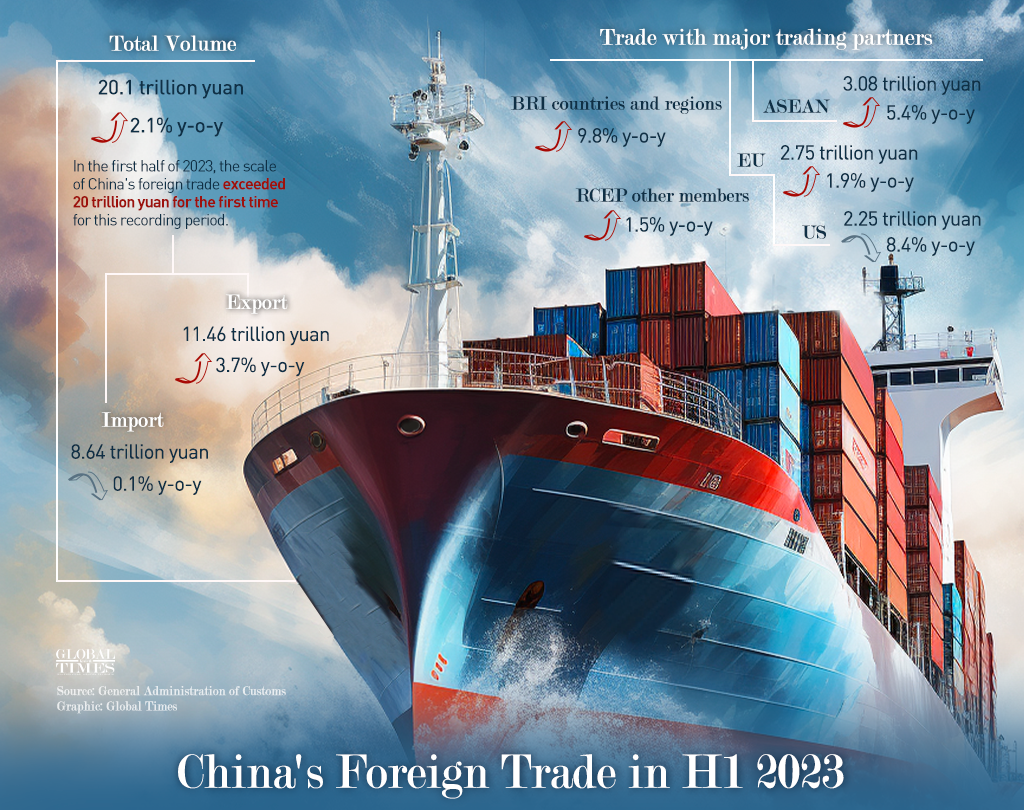
Robotic arms install vehicle and motorcycle wheel parts at an automotive parts assembly factory in a local industrial park in Huaibei city, East China's Anhui Province, on April 22, 2023. China's auto manufacturing and sales are gaining pace this year. Photo: VCG
Chinese officials said on Friday that China's economic recovery remains on track, with positive improvements in the economic cycle, residents' income and consumption, and has effectively coped with changes in the external environment amid an intricate and complex global geo-economic situation.
During a press conference in Beijing, officials from the People's Bank of China (PBC), the central bank, also said that challenges cannot be avoided and are normal during the economic recovery process, which usually takes about a year, and China is only halfway through. They also vowed further policy support to boost growth in the second half of the year, including possible cuts to the reserve requirement ratio (RRR).
Despite persistent downward pressure, China's GDP is still expected to record the fastest pace in two years in the second quarter, according to forecasts from domestic and foreign institutions and analysts. Pointing to sufficient room for policy support, many analysts also expect growth to further stabilize in the second half of the year and full-year growth will meet the official target and become a bright spot in global growth.
China is slated to release a slew of key economic indicators on Monday, including the second-quarter economic data and GDP in the first half of the year. Amid slowing pressure at home and downward pressure externally, many, especially foreign media outlets, have been casting doubts over the robustness of China's economic recovery.

China's foreign trade in H1 2023. Graphic: GT
'Challenges normal'Asked about claims that China's recovery pace is slower than expected at the press conference on Friday, Liu Guoqiang, deputy governor of the PBC, said that some macro indicators have fallen back, which sparked much discussion, but that does not reflect the full picture.
"There are indeed some problems that cannot be avoided. At the same time, we believe that when looking at the macro economy, we must not only remain problem-oriented, but also have a systematic concept, and we must see the positive side," Liu said, pointing to a series of positive signs in areas such as infrastructure investment, consumption and exports.
Liu further pointed out that some of the challenges currently facing the Chinese economy are normal during the post-pandemic economic recovery process, noting that internationally, it is believed that consumption and economic recovery takes about one year, and it has only been half a year since China started to recover from the pandemic.
"The fundamentals of our country's long-term economic growth have not changed, and we must have firm confidence in high-quality development," Liu said, while dismissing rather dire views on the Chinese economy, including deflation. "There is no deflation at present, and there will be no risk of deflation in the second half of the year."
In spite of downward pressure in the second quarter, many are still expecting fast GDP growth, citing a low base and improvements in various areas. In its latest forecast released on Tuesday, the Institute of Finance and Banking at the Chinese Academy of Social Sciences, an official think-tank, said that China's GDP growth reached about 7 percent in the second quarter on a yearly basis, noting "slowing recovery momentum and low base effect."
China's GDP grew 0.4 percent in the second quarter of 2022. Also pointing to that low base, a Reuters' poll on Thursday forecast that China's economy likely grew 7.3 percent year-on-year in the second quarter.
A GDP growth rate above 7 percent would mean the fastest pace since the second quarter of 2021, when growth hit 8.3 percent. In the first quarter of 2023, China's GDP grew by 4.5 percent.
Still, many also pointed out the slowing pressure facing the world's second-largest economy. The International Monetary Fund (IMF), for example, said on Thursday that China's economy is slowing due to weaker private investment, slowing exports and reduced domestic demand after a strong performance in the first quarter. The IMF is set to revise its forecast for China's growth later in the month, though the direction remains unclear. In April, the IMF forecast a 5.2-percent growth for China in 2023.
"Foreign media often use partial and unidirectional data to judge the overall picture and draw an overall conclusion, which is very biased," Hu Qimu, deputy secretary general of the digital real economies integration Forum 50, told the Global Times on Friday.
Hu said that while China's economic recovery faced slowing pressure in the second quarter, "I think it has bottomed out, and with the help of further monetary and fiscal policies in the second half, there should be no problem for meeting the annual growth target," he said.
China has set a GDP growth target of around 5 percent for 2023.
Brighter pictureChinese officials and analysts also drew a brighter picture for economic recovery in the second half and beyond, pointing to several factors including sufficient policy room.
"The prudent monetary policy will continue to be precise and powerful, and there is still sufficient policy space to deal with unexpected challenges and changes," Liu said. At the press conference, PBC officials also pledged to take more policy measures, including RRR cuts and others, to support various areas, including consumption, green finance, small businesses and the private sector.
Notably, the private sector has drawn widespread attention, with senior Chinese officials and relevant departments recently holding meetings and vowing increased support for private businesses.
Chinese Premier Li Qiang on Wednesday held a meeting with representatives from private e-commerce giants including Alibaba, Douyin, Xiaohongshu and Meituan, where he commended their development. He called on relevant authorities at all levels to create a fair and competitive market environment, along with improved policies.
"The government is frequently sending signals that it will boost the development of private companies," Hu said, adding that private businesses have done relatively well in the first half.
In the first half of 2023,
foreign trade of private businesses increased 8.9 percent year-on-year to 10.59 trillion yuan, and they became a "stabilizer" in China's foreign trade, Lü Daliang, a spokesperson with the General Administration of Customs (GAC), said on Thursday. China's total foreign trade grew by 2.1 percent year-on-year in the first half of the year to a record high, despite challenges.
Tian Yun, a Beijing-based economist, said that China's foreign trade could see some improvements in the second half, as the US is likely to end its rate hikes in the third quarter and China-US ties have eased to a certain degree, which bode well for China's foreign trade.
"Economic recovery in the second half of the year looks slightly more promising," Tian told the Global Times on Friday, pointing to a rebound in consumption due to the summer travel peak and greater policy support. "China will likely be the biggest contributor to global growth this year."
In a move that would also help expand infrastructure investment, a major growth driver, an executive meeting of the State Council on Friday approved a guideline on steadily carrying out construction of public infrastructure in megacities for both "normal and emergency uses," in a bid to coordinate development and security, according to China Media Group.
The meeting also urged efforts to ensure energy and power supply, as "China is currently in a critical period of economic recovery and industrial upgrading."
Apart from stable growth, the quality of China's economic development is also improving rapidly, officials and analysts noted.
China's economy is still steadily transitioning toward high-quality development, the impetus for scientific and technological innovation continues to strengthen, the green transformation is steadily advancing, the consumer market is gradually recovering and upgrading, and the strength of high-quality development is constantly accumulating, Liu said.
High-quality development has become a top priority for Chinese policymakers, who have taken a series of measures to improve quality. For example,
a meeting of the central commission for deepening overall reform on Tuesday stressed efforts to put in place new systems for a higher-standard open economy and to proactively lift the country's opening-up to a new level, part of China's efforts to foster high-quality development.





